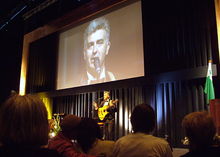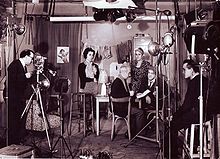Esperanto culture

The Esperanto culture is the culture of the Esperanto language community , which is primarily reflected in literature, common symbols and congresses and partly from genuine (e.g. original literature, independently coined phraseologisms ), partly from adopted elements (e.g. Translation literature, loan translations).
identity
At the first Esperanto World Congress, in Boulogne-sur-Mer in 1905, a "Declaration on the essence of Esperantism" was adopted; the followers of Esperantism , the “endeavor to spread the use of a neutral language throughout the world”, defined as “Esperantists” anyone who knows and uses the language, regardless of the purpose. It was also explained that the pursuit or non-pursuit of ideals in connection with the spread of the language is the private matter of each individual speaker.
Symbols
The most important symbol of Esperanto is a green pentagram on a white background, which can also be found in the Esperanto flag. The poem La Espero is considered the hymn of Esperanto. It speaks of world peace, unity and the lasting blessings of a neutral language.
The picture on the right is from VI. German Esperanto Congress from 1911. This is the most successful to date and should remain so for years to come. The picture on the right shows the congress participants from three member states in their traditional costumes, the young girl in a white dress with an Esperanto star that also carries an Esperanto flag. The people were symbolic of the different languages whose center was the young Esperanto.
The motto of the congress, “Those who bring a lot, will bring some something”, referred to the practical solution of the world language problem. The exemplary message of the picture was the simultaneous possibility of communication for everyone using the art language that connects them as a world language .
literature
In contrast to natural languages, written culture has a significantly higher priority, because unlike planned languages such as Ido , Occidental and Interlingua , Esperanto was designed as a literary language from the start. Esperanto literature has its own authors who write or have written in Esperanto. When it comes to translations into Esperanto, the major languages do not dominate. Translations played an important role in the early stages of Esperanto. They served to test and expand the possibilities of the language. Esperanto has its own phraseology with Esperanto -specific terms, proverbs, idioms and puns.
Remembrance and action days
On December 15th, the birthday of the inventor of the world auxiliary language, Esperanto speakers celebrate Zamenhof Day . An alternative name is "Day of the Esperanto Book". Another Esperanto day is July 26th. It recalls the publication of the first Esperanto textbook in 1887.
theatre

There were smaller plays at the First Esperanto World Congress in 1905. As part of the Esperanto World Congress in Dresden in 1908, Goethe's Iphigenie in Tauris was performed in Esperanto. In the 1980s and 1990s, the international group Kia Koincido played . For example, today there is a theater group in Toulouse (France).
Movies
Some films were also shot in Esperanto. The first feature film in Esperanto is Angoroj . The best-known film is Incubo, shot in 1966 with William Shatner in the lead role.
Cultural event
Occasional festivals have Esperanto culture as their theme. Such events took place in Scandinavia, Russia, Poland, Ukraine and France in 2005.
Museums and libraries
The International Esperanto Museum is located in Vienna . The associated collection for planned languages is part of the Austrian National Library . The German Esperanto Library is located in Aalen. The Hector Hodler library is located in Rotterdam (Netherlands).
Foundations and Awards
The city of Aalen, together with the FAME Foundation for the promotion of international communication tools, awards the FAME Esperanto Culture Prize. The Mondo Foundation has its own fund for Esperanto culture.
The World Esperanto Federation has organized the Belartaj Konkursoj (Fine Arts Competitions) every year since 1950 . Since 1976, only contributions written in Esperanto have been allowed in the poetry and prose categories . Since that year there has been a category for essays. These can also only be Esperanto originals. In 1984 the song category was added. In the United States, the Esperantic Studies Foundation (ESF) promotes Esperanto culture in many areas.
currency
In 1907, René de Saussure designed the Speso currency unit to facilitate communication among Esperantists on a financial level . An important promoter of this idea was the German banker and Esperantist Herbert Hoveler. For this purpose he founded the Ĉekbanko Esperantista, which issued checks on Speso. It was then used on a small scale by British and Swiss banks. The outbreak of World War I in 1914 ended the use of the Spesos. After the end of the Second World War in 1945, another attempt was made to establish a uniform world currency among Esperantists with the Stelo . This attempt also failed.
Others
The asteroid (1421) Esperanto , discovered in 1936, was named after the language and the asteroid (1462) Zamenhof, discovered two years later, after its inventor.
Herzberg am Harz describes itself as The Esperanto City .
See also
- Use of Esperanto
- Esperanto music
- Esperanto literature
- Homaranismo
- Prague Manifesto (Esperanto)
- Spatialism
- Stelo
- Speso
Web links
- German Esperanto Library (14,000 volumes, with interlibrary loan)
- Esperanto Museum and Collection for Planned Languages of the Austrian National Library
- Esperantic Studies Foundation (ESF)
Individual evidence
- ↑ Bulonja Deklaracio ; Declaration of pri la esenco de la Esperantismo (wikisource)
- ↑ Himno Esperantista ( Memento of February 9, 2006 in the Internet Archive ) Enciklopedio de Esperanto, letters H and Ĥ, keyword Himno Esperantista .
- ^ Blanke, Detlev : Interlinguistic contributions. On the nature and function of international planned languages . Edited by Sabine Fiedler . Frankfurt / Main u. a .: Peter Lang European Science Publishers, 2006, ISBN 3-631-55024-3 , p. 224f.
- ^ Ronald J. Glossop: La Kulturo de Esperanto .
- ↑ a b Fiedler, Sabine : Planned language and phraseology: empirical studies on reproduced language material in Esperanto. Verlag Peter Lang, Frankfurt, 1999. ISBN 3-631-34088-5
- ^ Fabian Handbook : German Esperanto Library .
- ↑ "tago de la esperanta libro" "La mondo festis Zamenhof tagon" , Libera Folio.
- ↑ Teatro Trupo Tuluzo
- ↑ Angoroj in the Internet Movie Database (English)
- ↑ imdb.com
- ↑ Kultura Esperanto-Festivalo (KEF)
- ↑ Esperanto - Lingvo Arta (EoLA)
- ↑ Artaj Konfrontoj en Esperanto (Arkones) ( Memento of the original from October 23, 2007 in the Internet Archive ) Info: The archive link was inserted automatically and has not yet been checked. Please check the original and archive link according to the instructions and then remove this notice.
- ↑ Velura Sezono
- ↑ Kultura kaj Arta Festivalo de Esperanto (KAFE)
- ^ Collection for planned languages of the ONB ( Memento of the original from December 18, 2007 in the Internet Archive ) Info: The archive link was automatically inserted and not yet checked. Please check the original and archive link according to the instructions and then remove this notice.
- ↑ a b Internet presence of the city of Aalen ( memento of the original from October 19, 2007 in the Internet Archive ) Info: The archive link has been inserted automatically and has not yet been checked. Please check the original and archive link according to the instructions and then remove this notice.
- ↑ Biblioteko Hector Hodler ( Memento of the original from October 6, 2007 in the Internet Archive ) Info: The archive link has been inserted automatically and has not yet been checked. Please check the original and archive link according to the instructions and then remove this notice.
- ↑ Website of the Mondo Foundation
- ↑ Belartaj Konkursoj 1950-1999 , Sten Johansson, 2000.
- ↑ detailed rules of participation ( memento of the original dated October 31, 2007 in the Internet Archive ) Info: The archive link was inserted automatically and has not yet been checked. Please check the original and archive link according to the instructions and then remove this notice.
- ↑ Overview with the winners from 1950 to 2007



